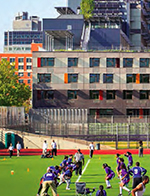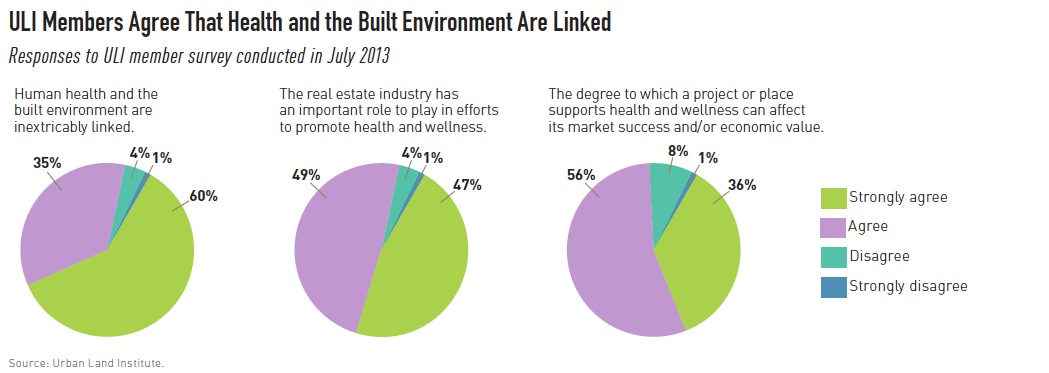URBAN LAND INSTITUTE
 About This Report
About This Report
Intersections: Health and the Built Environment explores the relationship between how healthy we are and the way our buildings and communities function. We can build our way to better health, it proposes, by changing our approach to cities, communities, and places. As real estate leaders and stewards of the built environment, we can do more to improve lives and foster healthy outcomes. And along the way, we can create places of enduring value.
Chapter 1: We Can Build Our Way to Better Health
In the 21st century, as the world meets the demands of population growth, increasing urban development, and climate change, we face new challenges in public health. Public health is no longer solely the business of health professionals: public officials, urban planners, transportation decision makers, architects, landscape architects, builders, and real estate developers all have a role to play in addressing public health challenges.
Many of today’s health challenges are driven by chronic or “lifestyle” diseases, including cardiovascular and respiratory diseases, type 2 diabetes, and cancer. These diseases now cause nearly two-thirds of deaths worldwide each year. By 2030, chronic diseases will cause 52 million global deaths per year, nearly five times the number of deaths from communicable diseases.
Epidemic rates of chronic disease have become a drag on the economies and futures of families, communities, nations, and whole regions. The growing cost of health care is a global megatrend that is making us rethink land use and transportation patterns. Health is becoming a competitive advantage or disadvantage for cities.
With this shift, market opportunities are emerging to change the way we design and build so that we support healthy living and vibrant economies. Like demographics, opportunities to be healthy are influencing what people want in their homes, workplaces, schools, public spaces, and communities. People care about their health. So what does that add up to for real estate?
Market demands from millennials and baby boomers are helping usher in active-living urban development. Millennials in particular express strong preferences for more compact, walkable, mixed-use, and mixed-income communities. They want amenities like storage for exercise equipment within buildings and easy access to parks and open space.
Overwhelmingly, baby boomers and older people want to age in place. They want housing and communities that can meet their needs as they grow older. And across the generations, demand is strong for communities with transit and other elements that support active living.
Health presents a market opportunity for forward-thinking developers and real estate leaders, and the market presents an opportunity to help shape communities in health-promoting ways.
Research points to how buildings, roads, and neighborhood design affect human health. When devising strategies for the built environment to improve health, we can also draw from decades of work on smart growth—many smart-growth approaches for the design, construction, management, and programming of communities also work for health.
ULI Leadership for Healthy Places
For many years, ULI and its members have been active players in discussions and projects that make the link between human health and development; we know that health is a core component of thriving communities. Through the Building Healthy Places Initiative, ULI is leveraging the power of its global networks to shape projects and places in ways that improve the health of people and communities.
Professionals involved in land use have a powerful role to play in creating healthy places. ULI members can lead in building healthier environments in the following ways:
- Through their organizations, by following principles of planning, design, and construction that incorporate healthy and sustainable practices, and by setting an example with healthy work environments and policies that encourage fitness and healthy eating;
- As a fundamental consideration in development projects, by incorporating elements that enhance health and the environment, such as selecting development sites with public transit access; building in compact ways, including amenities that promote healthy lifestyles; and using healthy building materials; and
- Through their influence on policy, by working with local and national governments, regional transportation agencies, foundations and community groups, and business, health care, education, and civic leaders to create land use, zoning, and building frameworks that are conducive to healthy lives.
The good news is that the real estate industry is getting on board. A summer 2013 survey of ULI members found that the majority understand linkages between health and the built environment; 96 percent strongly agreed that the real estate industry has an important role to play.
Download full report: Health and the Built Environment
About the Urban Land Institute (ULI)
www.uli.org
“ULI, the Urban Land Institute, is a 501(c) (3) nonprofit research and education organization supported by its members. Founded in 1936, we now have members worldwide, representing the entire spectrum of land use and real estate development disciplines working in private enterprise and public service.”
Tags: ULI, Urban land Institute







 RSS Feed
RSS Feed